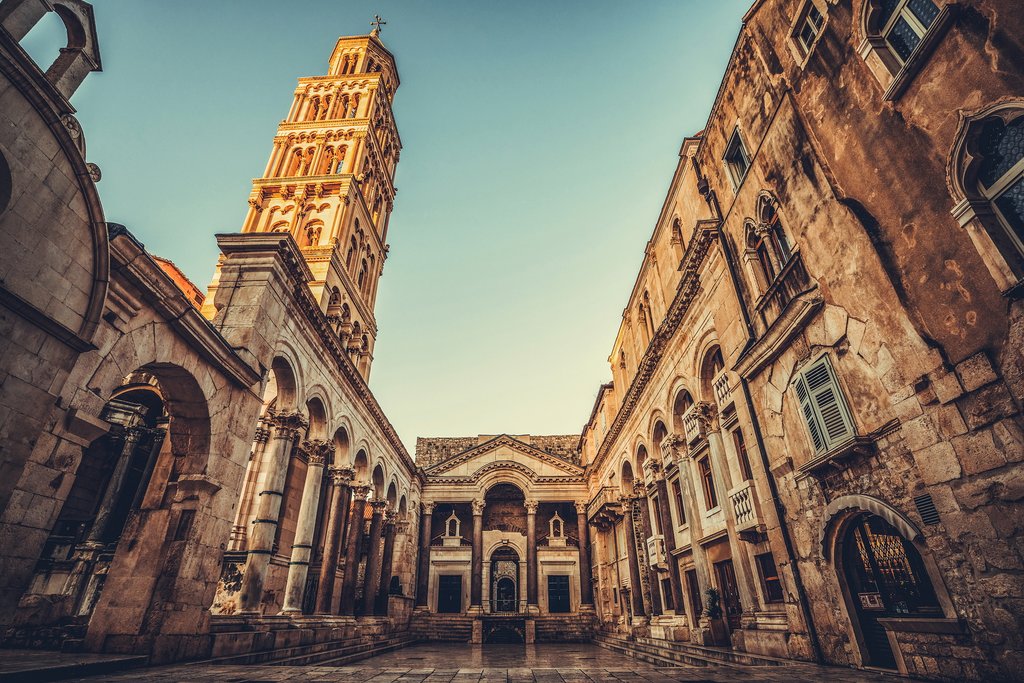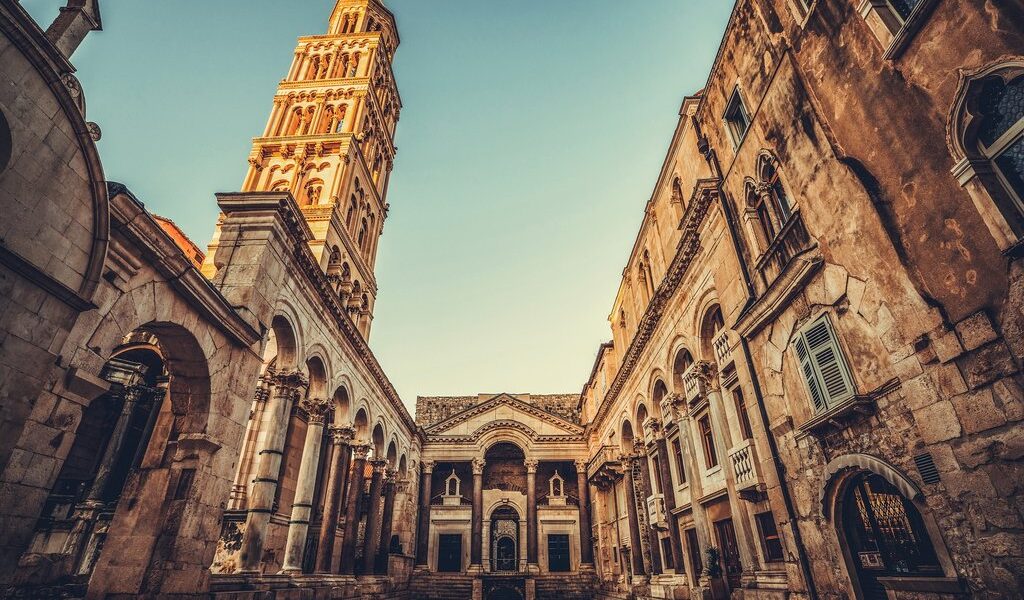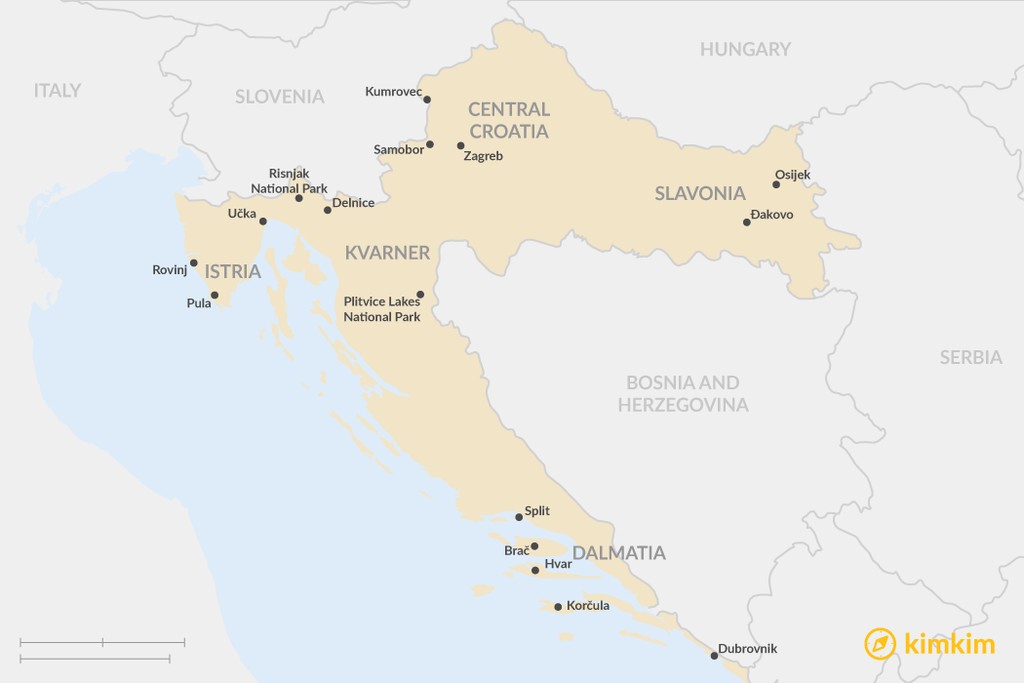
When you picture Croatia, chances are you’re thinking of Dubrovnik and the Dalmatian Coast first. But this popular area is only one of the country’s five regions, each one of them worth a trip on its own. From mountains and national parks to beaches and islands, from cities to tiny villages, here’s where (and when) to get the most out of Croatia.
## Unveiling the Wonders of Croatia: A Journey Through Diverse Regions
Croatia, a nation shaped like a boomerang embracing the glistening Adriatic Sea, unveils a breathtaking panorama of over a thousand enchanting islands. This captivating land extends upwards into the majestic Dinaric Alps, a dramatic backdrop for the country’s vibrant cities and stunning natural landscapes. Imagine a place where the cuisine mirrors the delights of Italy, yet offers greater affordability, and where the warmth of the people rivals even the famed hospitality of Italy. This is Croatia, a former Yugoslavian nation that has steadily risen to prominence on the discerning traveler’s radar. Yet, amidst its growing popularity, there remain pockets of tranquility, spaces where you can truly lose yourself in the beauty and serenity of the surroundings.
Croatia presents itself as a choose-your-own-adventure destination, a land teeming with diverse sights and experiences waiting to be discovered. Therefore, it is paramount to carefully select the region that resonates with your personal desires and preferences, and then, embark on an unforgettable journey of exploration.
## Dalmatia: A Coastal Paradise
**(Image of Dubrovnik, Croatia’s star attraction)**
Dalmatia, the region most frequented by first-time visitors to Croatia, is undeniably captivating. Its allure stems from its long and picturesque coastline, adorned with a myriad of islands, culminating in the nation’s most iconic destination: **Dubrovnik**. This remarkable city, once scarred by the ravages of the Balkan War in the 1990s, now faces a different kind of challenge – the overwhelming influx of tourists. Imagine a golden-roofed city, encircled by formidable stone walls, perched upon an inlet that gracefully extends into the azure waters of the Adriatic. **Dubrovnik**’s streets shimmer, seemingly paved with the finest marble, and are alive with the vibrant energy of cafes spilling onto bustling squares. Ramshackle buildings, interconnected by a charming network of laundry lines, add to the city’s unique character.
However, Dalmatia’s appeal extends far beyond the captivating city of **Dubrovnik**. The region boasts numerous other coastal gems that rival its beauty, yet offer a more tranquil experience, free from the thronging crowds. Consider **Split**, often referred to as Dalmatia’s “second city,” a vibrant hub with a bustling harbor and the awe-inspiring **Diocletian’s Palace**, an expansive complex of Roman buildings that transports visitors back in time. Then there’s the island of **Korčula**, renowned for its old town, strikingly similar to **Dubrovnik**’s, and a burgeoning wine scene that is steadily gaining recognition. And let’s not forget **Brač**, celebrated for its gourmet food producers and the distinguished native stone that has been used in the construction of iconic structures such as the White House and Berlin’s Reichstag.
Finally, there is the alluring island of **Hvar**, widely acclaimed as Croatia’s most beautiful. Here, quaint villages and secluded beaches are separated by fragrant lavender fields and lush olive groves, creating a scene of idyllic beauty. To put it simply, as you journey south by boat from **Split** towards **Dubrovnik**, each island you encounter seems even more captivating than the last.
## Istria: A Fusion of Cultures and Flavors
**(Image of Opatija, a town on the coast in Istria)**
Roman villas and amphitheaters stand alongside pristine beaches and vibrant towns brimming with culinary delights. This description could easily apply to Italy, and indeed, Istria’s history is deeply intertwined with its Italian neighbor. Once a part of the **Venetian Republic**, this northern peninsula, shared with **Slovenia** and **Italy**, has witnessed numerous shifts in power throughout its history. However, rather than becoming a source of conflict, this multilayered past has transformed Istria into a destination that caters to a diverse range of interests.
History enthusiasts can trace the Roman Empire’s legacy through the region’s well-preserved ruins. Those interested in more recent history can discover remnants of the Napoleonic and Austro-Hungarian empires scattered throughout the landscape. Foodies will find themselves in paradise, indulging in an abundance of wine and truffles that rival Italy’s offerings. The coastal towns vie for attention with the stunning islands of the Dalmatian Coast, while the medieval hilltowns serve as bastions of art, with cobblestone streets lined with captivating art galleries.
In the port town of **Rovinj**, red-roofed houses cluster together on a headland beneath the campanile of **St. Euphemia**, creating a picturesque scene. Here, the population is truly bilingual, and visitors will feel an undeniable connection to Italy. The main market offers a treasure trove of fresh produce, while numerous galleries showcase the region’s artistic talent. Alternatively, simply wander through the town’s charming streets, soaking in its unique ambiance. In **Pula**, the **Temple of Augustus**, the **Triumphal Arch of Sergii**, and the **Pula Arena**, a magnificent Roman amphitheater, compete for your attention alongside countless inviting beaches. This harmonious blend of historical significance and scenic beauty makes Istria a destination that appeals to everyone, and an increasing number of visitors are beginning to recognize its allure.
## Central Croatia: A Blend of History and Culture
**(Image of Zagreb’s National Theater)**
Venture northeast into Croatia’s interior, the heartland that encompasses the capital city of **Zagreb**, and you’ll experience a distinct shift in atmosphere, almost as if you’ve crossed into another country. The contrast is striking between the breezy, Italianate coastline and the more Eastern European character of the central region, characterized by its churches, abbeys, and medieval towns and castles. Many visitors choose **Zagreb** as their base, and it’s easy to understand why. This cosmopolitan capital exudes the charm of a lived-in Prague or a Vienna from a bygone era.
**Zagreb** is divided into an **Upper Town** and a **Lower Town**, with vintage trams gliding along main avenues lined with grand buildings and churches adorned with mosaic-tiled roofs. The city boasts wide plazas and intimate courtyards, and its abundance of street art rivals even Berlin’s vibrant scene. A particularly popular attraction is the Museum of Broken Relationships, a poignant collection of mementos dedicated to failed romances, housed within a Baroque palace.
Another intriguing destination is the town of **Kumrovec**, home to an outdoor museum that showcases the lives of its inhabitants over the past 200 years, albeit with a Communist perspective (it was built to glorify the Yugoslavian dictator Tito). The nearby town of **Samobor** has also become a popular day trip destination, a hilltown renowned for its rich tradition in crafts and sweets, including its famous *kremšnita* cream cake. This is a typical stopover en route to hiking, biking, or paragliding in **Nature Park Žumberak**, but even simply wandering through its streets, admiring the medieval homes, is a rewarding experience.
## Kvarner Region: Nature’s Masterpiece
**(Image of The emerald waters of Plitvice Lakes National Park)**
The Kvarner Region may be less known than Dalmatia, but it holds one of Croatia’s most iconic natural wonders: the **Plitvice Lakes National Park**. This sprawling wonderland of waterfalls cascading into crystal-clear pools has become a major attraction in Croatia, its popularity mirroring that of **Dubrovnik**.
For first-time visitors to Croatia, **Plitvice** offers a compelling reason to venture away from the coast. This meticulously maintained area, Croatia’s first national park, evokes an Edenic atmosphere, with wooden walkways winding across lakes and past breathtaking natural rock formations. However, it can also become crowded with visitors seeking the same picture-perfect views. Therefore, it’s best to visit during the off-season, when the waters remain vibrant but the summertime crowds have dispersed.
Many visitors to **Plitvice** are unaware that Kvarner is also a haven for mountain bikers, drawn by its two main trails: the **Gorski Kotar cycling transversal** and the **Rijeka Ring cycling transversal**, which connect its main natural attractions and towns. The region also hosts the annual 4 Islands MTB Stage Race, a multi-day team event held every April across Krk, Rab, Cres, and Lošinj.
Further afield, two other national parks, **Risnjak National Park** near **Delnice** and **Učka Nature Park**, provide a sanctuary for cyclists and hikers. As this region of Croatia gains recognition among athletes and nature enthusiasts, its popularity will undoubtedly continue to grow. Therefore, the best time to visit is now, before it becomes even more crowded.
## Slavonia: A Glimpse into the Past
**(Image of The main square in the Slavonian town of Daruvar)**
If you feel as though you’ve taken a wrong turn and ended up in Croatia instead of Hungary or Austria, then Slavonia is the region for you. Once a part of the Austro-Hungarian Empire, which spanned from Switzerland to modern Russia for half a century, Slavonia proudly displays its history through its opulent castles and Danube River cities that rival even Budapest. Its relatively low profile, compared to popular destinations like Dalmatia and Istria, also means you’re likely to encounter a rare sight: few, if any, tourists, and a genuinely friendly, authentic atmosphere.
Among its many cities are **Ɖakovo**, home to the red-brick **Cathedral of St. Peter**, long considered one of the most beautiful in Europe; **Slavonski Brod**, where the 18th-century **Brod Fortress** was built to defend the Austro-Hungarian Empire against the Ottomans; and **Osijek**, with its elegant squares and Baroque buildings. Additionally, you can expect to see locals in traditional costumes at numerous regional festivals, including the **Vinkovci Autumn Festival** of folklore, featuring live music and dancing every September.
Delve deeper, and you’ll discover hidden art galleries, wine cellars that have stood for a century, quirky museums, and even hot springs known only to the locals. Its laid-back, lived-in ambiance feels like a remnant of another era, and the slower pace of life makes it the perfect place to unwind and recharge. Visit with your family or take some time to relax before exploring **Dubrovnik** or sailing the Dalmatian islands. Unlike the rest of Croatia, Slavonia appears to be timeless.


